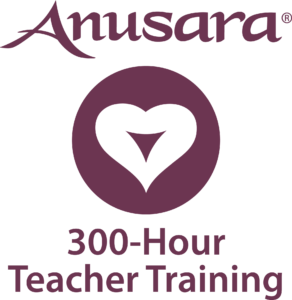300-Hour Advanced Anusara® Teacher Training (300TT)
The primary objective for the 300-Hour TT is to provide structure for Anusara Elements and Inspired teachers to continue their education and training in two main areas:
- Teaching high quality Anusara® yoga.
- Further develop, refine, and expand on the teaching skills that were introduced in the 200-Hour Basic Teacher Training.
- Prepare Anusara Elements and Inspired teachers to pass the written exam and class video assessment to become Certified Anusara Teachers
- Expand on the ability to provide an inspiring experience of Anusara yoga for all of their students, including specialized groups
- Deepen experience, understanding, and practice:
- Advanced training in asana and other yoga practices such as pranayama and meditation
- Advanced studies of original Non-dual Tantric scriptures and Applied Anatomy
Training Overview
Required Modules (total = 144 hours):
The 300TT curriculum includes 9 required modules, each one consisting of a minimum of either 12 or 24 hours of class time, totaling 132 hours of class time plus 12 non-contact hours (see below for description)
- Teaching with the Universal Principles of Alignment – Minimum 12 contact hours
- Teaching with a Theme – Minimum 12 contact hours
- Sequencing – Minimum 12 Contact Hours
- Observation and Adjustments – Minimum 12 contact hours
- Anusara Methodology and Co-Mentoring – Minimum 12 contact hours & 12 non-contact hours
- Philosophy – Minimum 24 contact hours
- Functional Anatomy as it Applies to Yoga – Minimum 24 contact hours
- Teaching Meditation – Minimum 12 contact hours
- Teaching Pranayama – Minimum 12 contact hours
Elective Hours (total = 156 hours):
- Repeat or take more than the minimum number of hours of the required modules
- Elective modules, such as Woman and Yoga or Yoga for Seniors
- Repeating or assisting in an Immersion or the 100-Hour Teacher Training
- Workshops with a Certified Anusara Teacher, as long as the subject matter is in alignment with one or more of the essentials of Anusara Yoga, namely, the Universal Principles of Alignment, non-dual Tantra, and the 3 A’s.
- Up to 36 hours with a licensed Subject Matter Specialist.
Detailed Student Handouts are provided for each required module.
Scheduling a 300-Hour Teacher Training – Teacher and Student
An Experienced Certified Anusara Teacher (E-CAT) can teach any and all of the 300-Hour Anusara Teacher Training modules, so the E-CAT can schedule a complete 300-Hour Teacher Training, or they can put individual modules on their teaching schedules.
Also, a licensed Subject Matter Specialist (SMS) can teach the subject that they are licensed to teach.
Students can take all the modules from one E-CAT, or they can take them in any combination from any number of E-CATs or Subject Matter Specialists.
Prerequisites for the 9 Required Modules
- Completed the 200-Hour Anusara Teacher Training Program, Or
- Has a 200-Hour certificate from another style of yoga and completed the 36-Hour Anusara Bridge Program
- For Philosophy: no pre-requisite, but the students need to know that for part of the time we will be contemplating how to apply the philosophy to teaching with a theme.
Summary of the Required Modules
Teaching with a Theme
Teaching with a class theme is one of the hallmarks of Anusara® yoga. Themes inspire both teacher and student to connect the asana practice to a deeper meaning in yoga and life. Although teaching with a theme is introduced in the 200-Hour Anusara Yoga Immersion and Teacher Training, it often remains a skill that is not well understood or honed by Anusara teachers. In this module, we will share a group of simple but coherent methods to make class themes that are authentic and powerful.
- Review theme, heart quality, and the main elements of a class plan built around a theme
- Practice ways to develop & personalize themes directly
- Various techniques for weaving theme into the asana:
- Connecting theme to heart quality, and heart quality to Universal Principle(s) of Alignment™ (UPA) and asana
- Mini-dharma talks
- Metaphors and imagery, including from the natural world
- Storytelling
- Connecting to the Midline
- Consider strategies, rhythms and sequence for the weaving of a theme into the flow of a class
Teaching with Universal Principles of Alignment
Anusara® yoga is an alignment-based method, which includes both held poses and skillful flow (vinyasa). The UPA’s bring intelligent biomechanical alignment and movement to both form and flow and make Anusara an asana method that can reliably stabilize, strengthen and move body, mind and heart.
- Explore basic anatomy and kinesiology corollaries to the UPA’s
- Understand the UPA’s energetically, philosophically, poetically and metaphorically.
- Connect the UPA’s to the higher or subtler purposes of our practice of asana.
- Teaching Practice and Exercises (Practicum)
Advanced Sequencing
Sequencing is one of the most important skills required to teach an Anusara yoga class. Since we don’t have any prescribed sequences, we sequence asanas using sequencing principles that are based on the biomechanics of the body and deep knowledge of asana. The main topics covered in this module are:
- Key sequencing principles
- The “potpourri sequence” and the “apex pose” sequence
- The role of the various class of poses in a Potpourri Sequence such as standing, hip openers and inversions.
- Theme for a class with an pose Apex Pose Sequence
- Key actions or principles of alignment for each class of poses
- Sequencing for beginners, a mixed level class, and an intermediate/advanced level class.
- Creating Course Curriculum – how to sequence a series of classes over a period of time.
Observation and Adjustments
Observation is the art of seeing our students on all levels of their being. After truly seeing our students we can make more intelligent and respectful decisions about whether to adjust or not, and HOW to make our adjustments most effective.
- Look for the Qualities of an Aligned Body
- Use a Basic Alignment Blueprint to Map Decisions
- Sensitivity – Stability – Adjustment
- Practice use of clear and articulate language
- Types of Adjustments
- Touching – Ethics, Efficacy and Parameters of Touch within Yoga Practice
- Key Poses to Know How to Physically Adjust
Anusara Methodology and Co-Mentoring
This module is in two parts, with 12 contact hours and 12 non-contact hours.
In the 12 Contact Hours, we summarize the 13 teaching elements of the Anusara® yoga method, such as Teaching with a Theme, Observation and Adjustments, Sequencing and Teaching with the UPA’s. Then we will specifically focus on:
- Coordinating major movements and actions with the breath
- Guidelines for verbal instructions, such as plain, active, explicit, linking, giving direction
- Postural demonstrations
We will also introduce and practice the skills of giving and receiving feedback, which will prepare the students for the 12 Non-contact hours of Co-Mentoring.
For the 12 non-contact hours, the teacher trainees pair up, and in their own time, practice what they learned in each required module. They will help each other integrate the skills so they can easily pass the Anusara Certification video and exam.
Philosophy, focusing on one or more texts of Non-Dual Tantra
The graduate of the 200-Hour Anusara® Yoga Teacher Training received a brief introduction to some of the main concepts of non-dual Tantra and an introduction to teaching asana with a class theme. Class themes are supported by the philosophy – the philosophy provides context and depth for the themes.
In this module, we will explore one or more primary texts of Non-Dual Tantra, in order to support our sadhanas, our teaching with a theme, and our lives. Our Student Handout focuses on the profound text, the Pratyabhijnahrdayam or “Heart of Recognition”, however, an E-CAT might teach one or more of the other great Shaiva Tantra texts for this module.
The module includes:
- A brief review of the history of non-dual Tantra
- Overview of the main teachings
- Practices of meditation, contemplation, expansion, recognition, remembrance, and moment-by-moment awareness of our patterns of action and thought in daily life
- How to apply the philosophy to our teaching of asana with a class theme
Functional Anatomy
Are you interested in how the parts of the body work together as it relates to asana and improved health?
- Study the main movements possible in a human body such as flexion, extension, twisting, and asymmetrical poses.
- With each main movement, we’ll discuss and practice these primary teaching skills:
- Knowledge of the primary and secondary places of movement in these main classes of poses;
- Key observation points and verbal adjustments to get into a safe pose
- Key actions to teach in each class of postures
- Main precautions of each movement type.
- How to deal with some of the most common conditions in classes.
Teaching Meditation
From the beginning and until the second half of the 20th century, the main practice of yoga was meditation. Meditation is to sit quietly with eyes closed and take the journey to, what in Tantra is known as the “Heart”, in Vedanta is known as the atman or inner Self, and in Classical Yoga is known as the Purusha or pure awareness.
Today, most yogis begin yoga with the asana practice, and asana practice remains the main practice of Anusara® Yoga. A regular asana practice often leads to an interest in meditation, and our asana practice supports meditation in many ways. At the same time, meditation is a wonderful complement and support for our hatha yoga practice, and for many asana practitioners, the meditation practice becomes the central pillar of their sadhana.
The Meditation module covers four main topics:
- An introduction to the practice of meditation, including definitions, the theory behind the practice
- Why we meditate with the benefits that are experienced on all levels of our being. How to practice and the relationship of meditation to our other main practices.
- A simple 3-step template for teaching meditation, which we call “Creating Space for Meditation”, and a more complex 4-step template for teaching meditation.
- Using a class theme to create a meditation dharana.
Teaching Pranayama
A formal pranayama practice can provide health enhancing and transformational benefits to every aspect of being – physical, mental, emotional, and spiritual. Even a less-than-formal practice of pranayama and breathing techniques, within the context of a well-rounded yoga asana practice, will bring great benefit. Traditional yogic texts make robust claims for the benefits of pranayama, and there is ample research-based evidence to support many of these claims, but as important as the theory and the science is your direct experience and practice of pranayama.
Included in this module:
- Review of the pranayama techniques introduced in the Anusara curriculum and refinement of our understanding and application of these techniques
- Consideration of how to begin or deepen your personal practice of pranayama
- Learning to more skillfully teach the Pranayama techniques that one regularly practices
- Cultivation of greater proficiency in bringing breathing and pranayama into the active portions of the asana classes
- Deepening understanding of prana and the subtle body
- Developing one’s own unique way of expressing the experience and understanding of prana and pranayama





